This post may contain affiliate links. Please read our disclosure policy.
Introducing the most AMAZING vegan salmon sashimi! You will never believe this “salmon” is actually 100% vegan! It’s rich, buttery, slightly fishy, and melts in your mouth. Perfect for nigiri, sushi, poke bowls, and more!
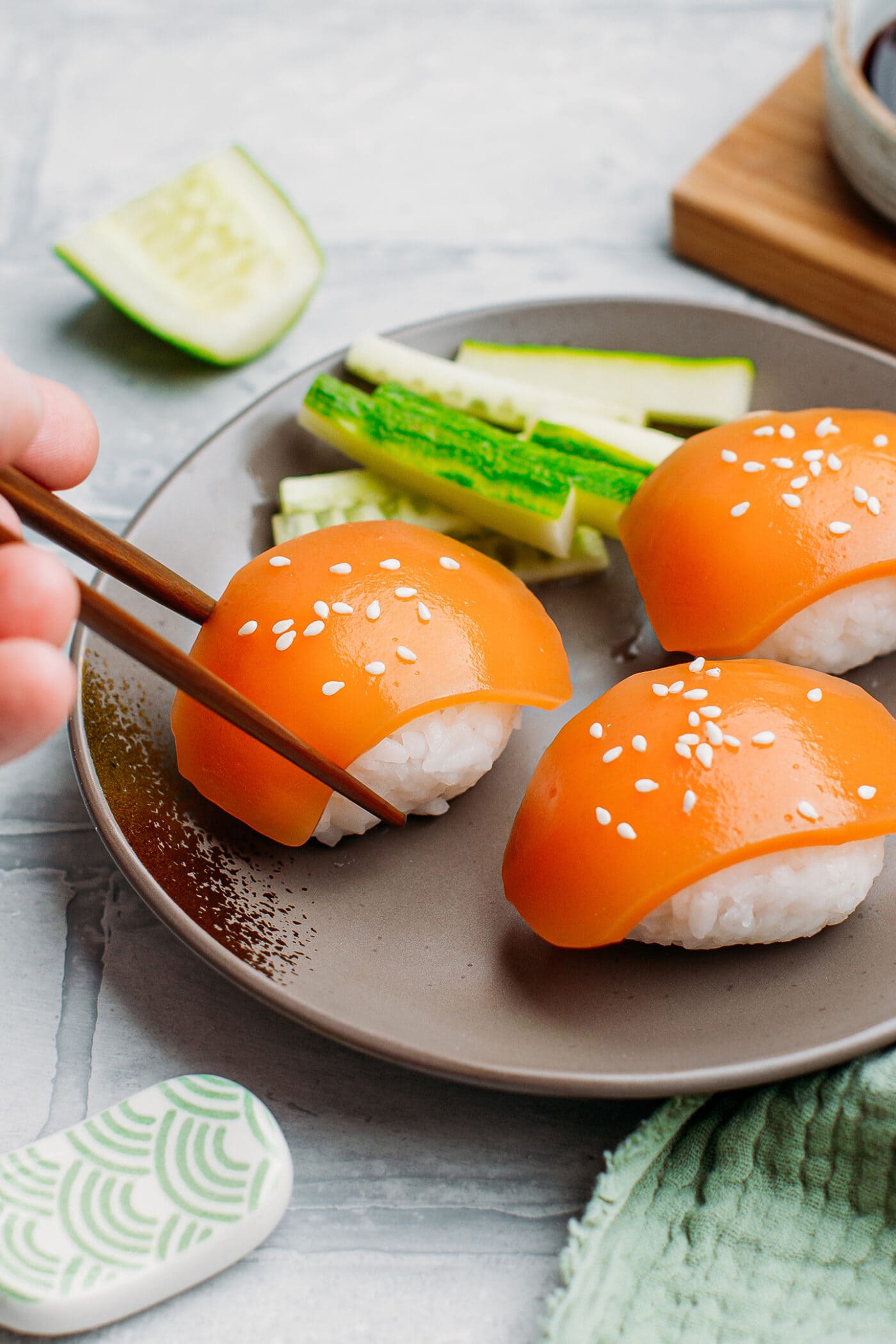
I’m super excited to finally release this recipe! It took so many trials that it has been in the works for months.
This recipe is inspired by Zeastar salmon and another brand I tried in a vegan sushi restaurant.
⭐️ Why You Should Try This Recipe
- It looks and tastes so much better than carrot salmon. Forget about carrot lox. This vegan salmon sashimi is the new star in town. It’s just mindblowing. It has a fresh and fishy flavor and a fatty mouthfeel. Even non-vegans approved of this recipe!
- It’s just perfect for sushi. Thinly sliced, this vegan salmon makes the perfect sushi component, whether it is for nigiri, maki, or uramaki. It’s also great for poke bowls!
- It’s much cheaper than store-bought. Vegan salmon sold at the store is outrageously expensive and pretty hard to find. This homemade version makes use of affordable ingredients and tastes even better.
📘 What is Sashimi
Sashimi (刺身) is a Japanese dish that consists of raw fish or meat cut into thin slices. It is traditionally served with a soy dipping sauce. Sashimi can be served as is, or on top of sushi rice (nigiri).
🌱 Ingredient Notes
This recipe will take you about 20 minutes and just 8 ingredients. Here is what you will need:
- Jelly powder – Also known as Konnyaku jelly. It’s a key ingredient to this recipe, yielding a slightly chewy texture and helping the vegan salmon firm up. I recommend the Jim Willie Konnyaku, which you can find online or in almost all Asian supermarkets.
- Tapioca starch – The role of tapioca starch here is to create a better texture, adding just a hint of elasticity. It also makes the salmon less translucent.
- Almond milk – Adding some milk prevents the salmon from looking too translucent. Make sure you are using unsweetened plant-based milk.
- Seaweed – To create a fishy, ocean flavor. We will be infusing it in the water.
- Salt and sugar – For flavor.
- Oil – The addition of oil gives the salmon its fatty mouthfeel. While you could leave it out, I highly recommend you don’t, as it really helps create a more realistic texture.
- Food coloring – We will use orange food coloring to color this vegan salmon. Make sure you use vegan food coloring, as some may contain animal products.
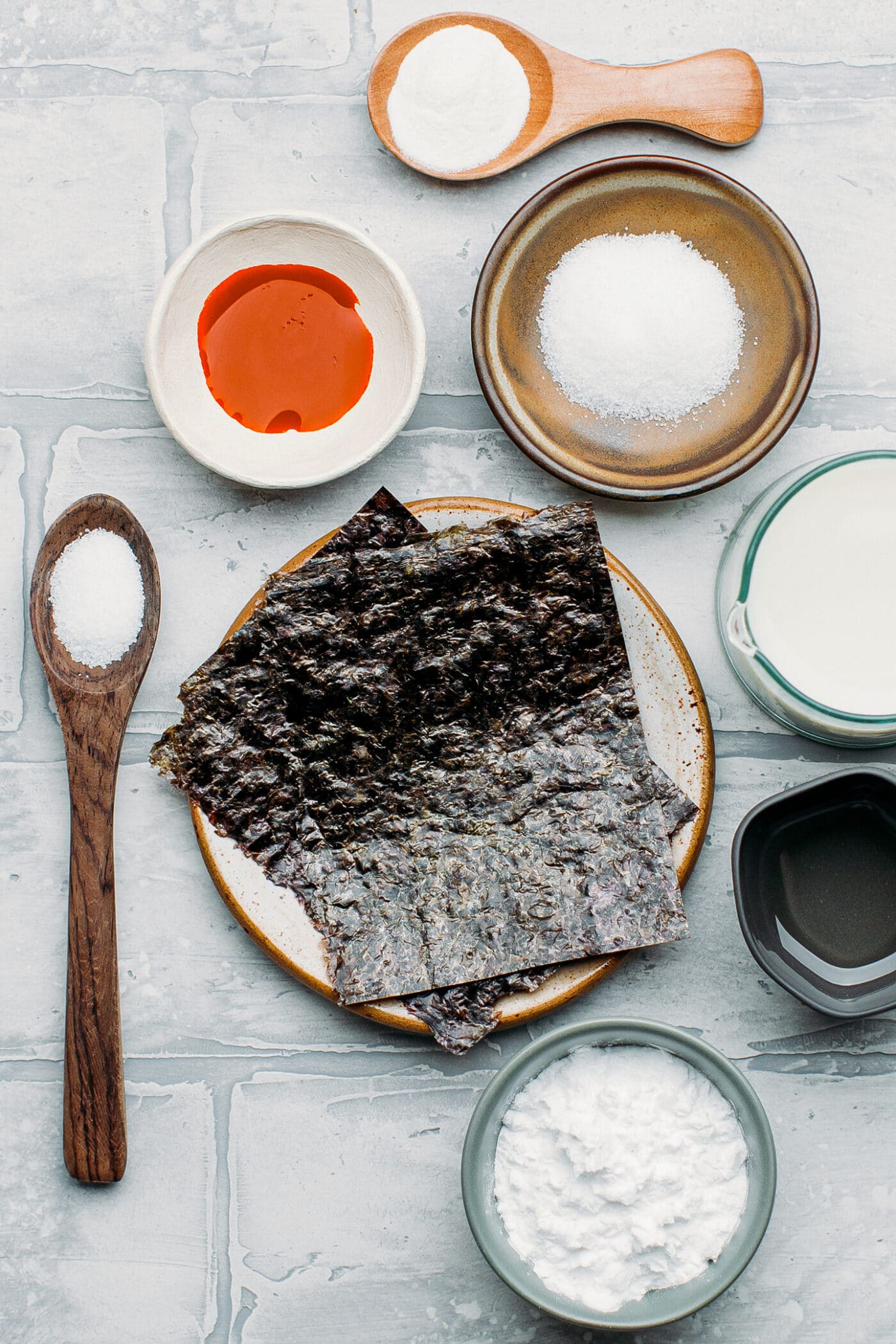
🍣 How to Make Vegan Salmon
It starts with the seaweed that is infused in hot water for a few minutes. This is what will give the “salmon” its ocean-like flavor. You can use nori or wakame; both work.
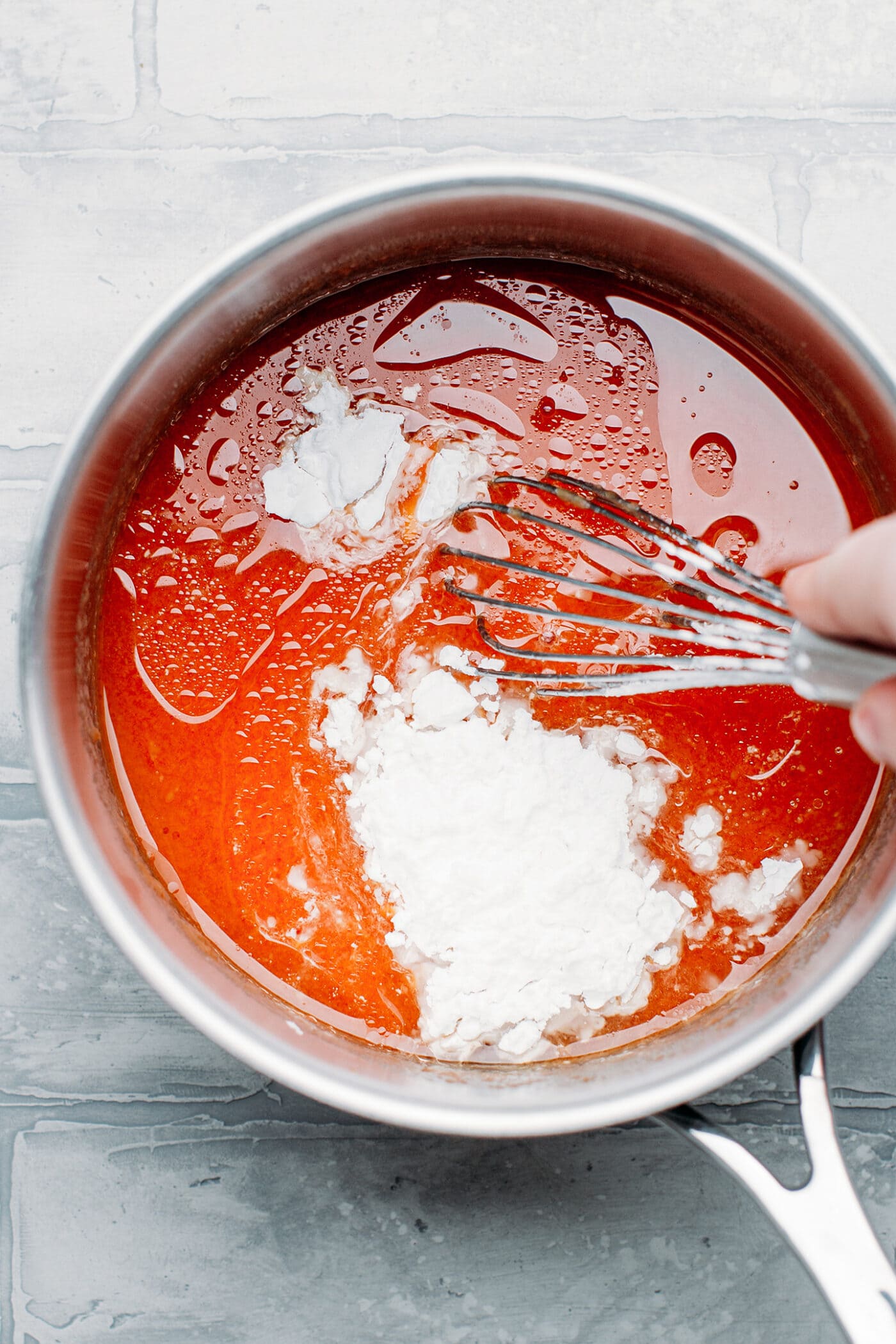
Next, it’s time to prepare the salmon!
- Strain the seaweed and discard it. Transfer the seaweed water to a saucepan and add the rest of the water.
- Add the almond milk, sugar, salt, tapioca starch, and Konnyaku powder. Whisk until everything is combined and the starch is dissolved.
- Pour in the food coloring and the oil and whisk again.
- Heat over medium heat, constantly whisking, until the mixture comes to a boil and thickens. Once thickened, transfer to a small pan or container.
- Let it cool for 2-3 hours or until firmer.
- Remove from the pan and slice into thin slices. Enjoy!
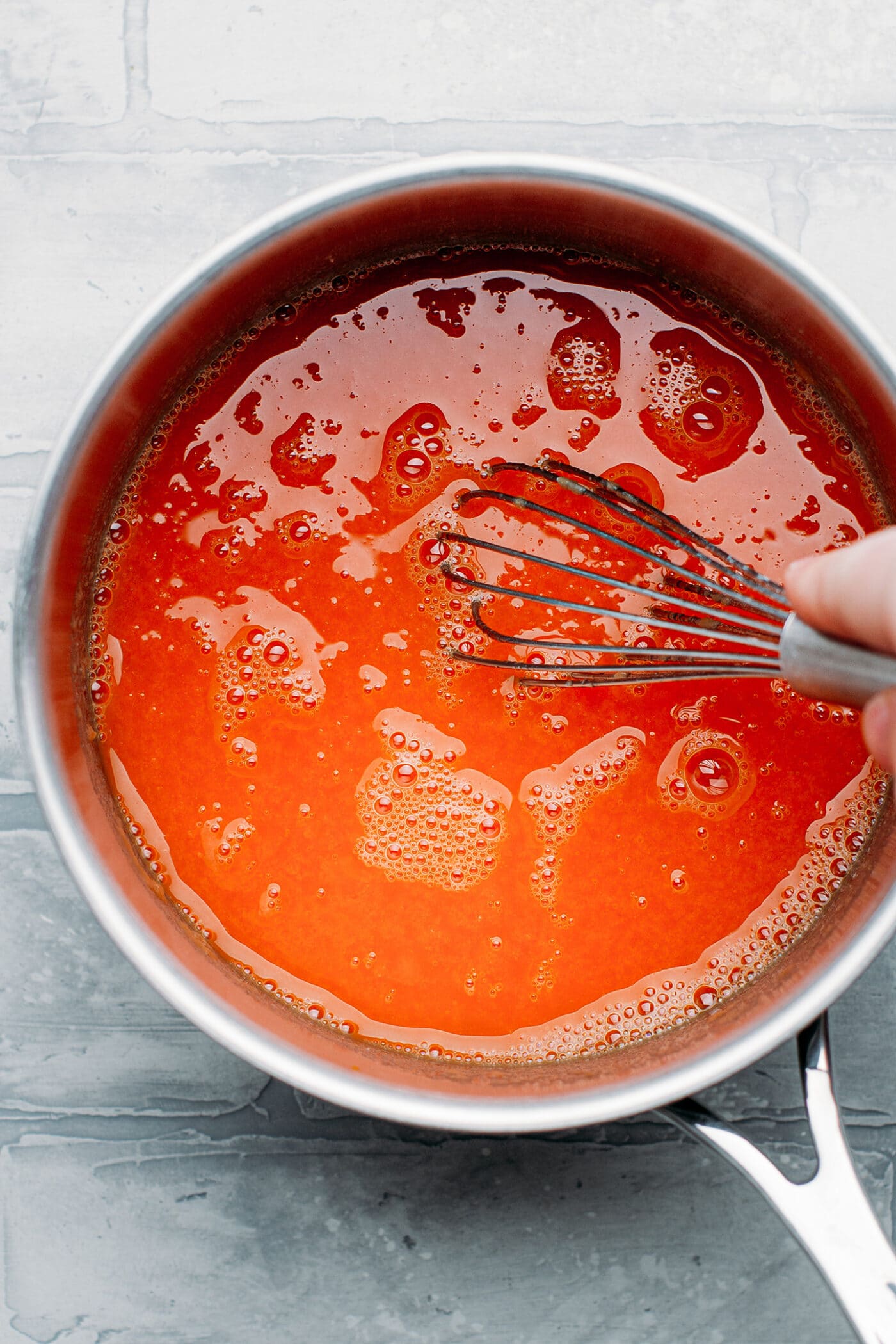
For a Smoked Salmon Version
If you are looking for a smoked salmon version, add 1/8 teaspoon of liquid smoke. This type of salmon will be perfect to use on cream cheese toast!
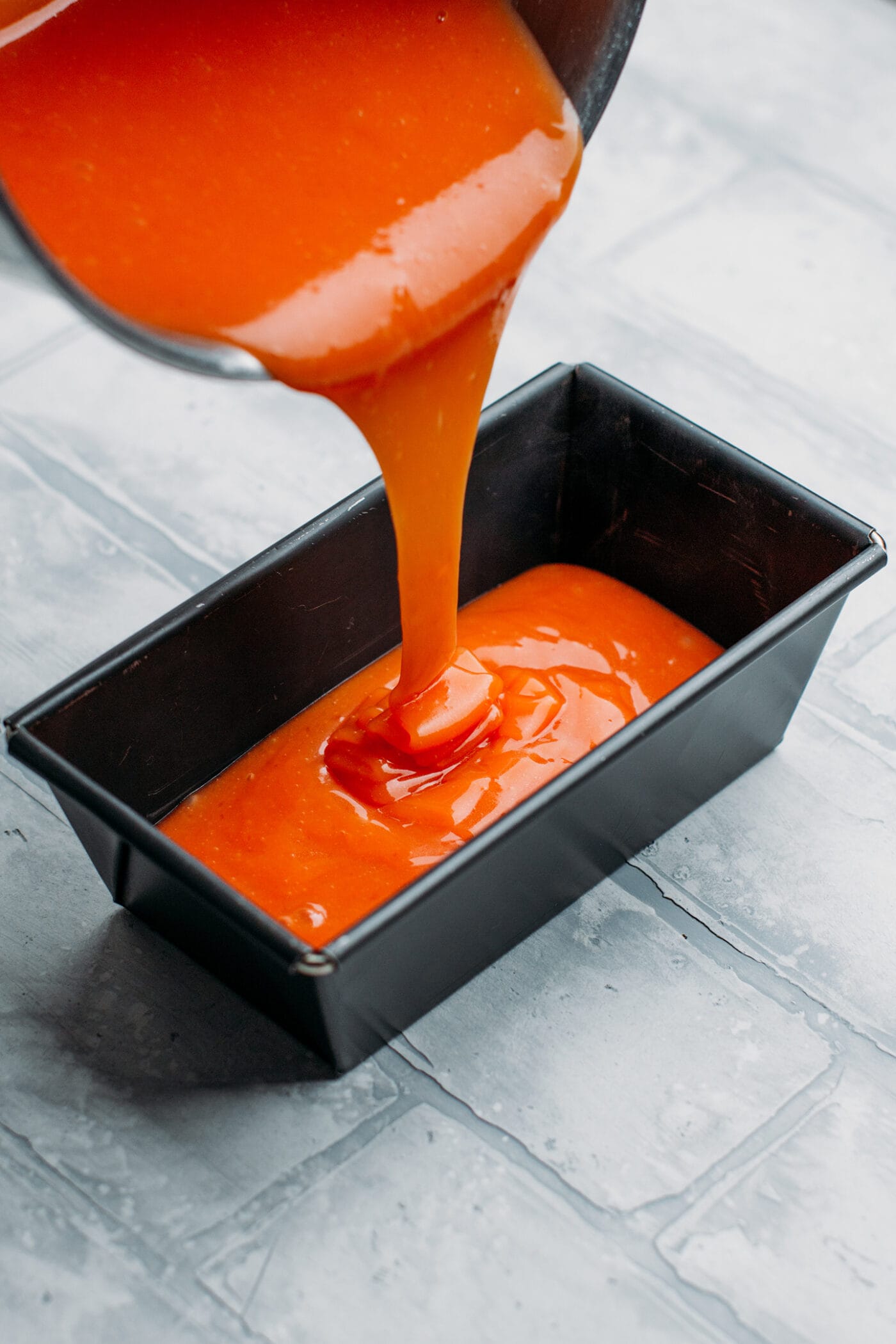
🍚 How to Use It
This vegan salmon is incredibly versatile and can be used in a handful of ways:
- Sushi or nigiri: Cut into sticks, it can be used in California rolls or Maki. Thinly sliced, you can use it to make nigiri.
- Poke bowls: Or sushi bowls. Cut the vegan salmon into small cubes and toss them with soy sauce, minced ginger, and a splash of rice vinegar.
- Salmon cream rolls: Spread a thin layer of vegan cream cheese on a slice of vegan salmon and roll it up into a roll. Enjoy chilled as an appetizer!
- Sandwiches or bagels: Serve with cream cheese, capers, onions, and fresh herbs.
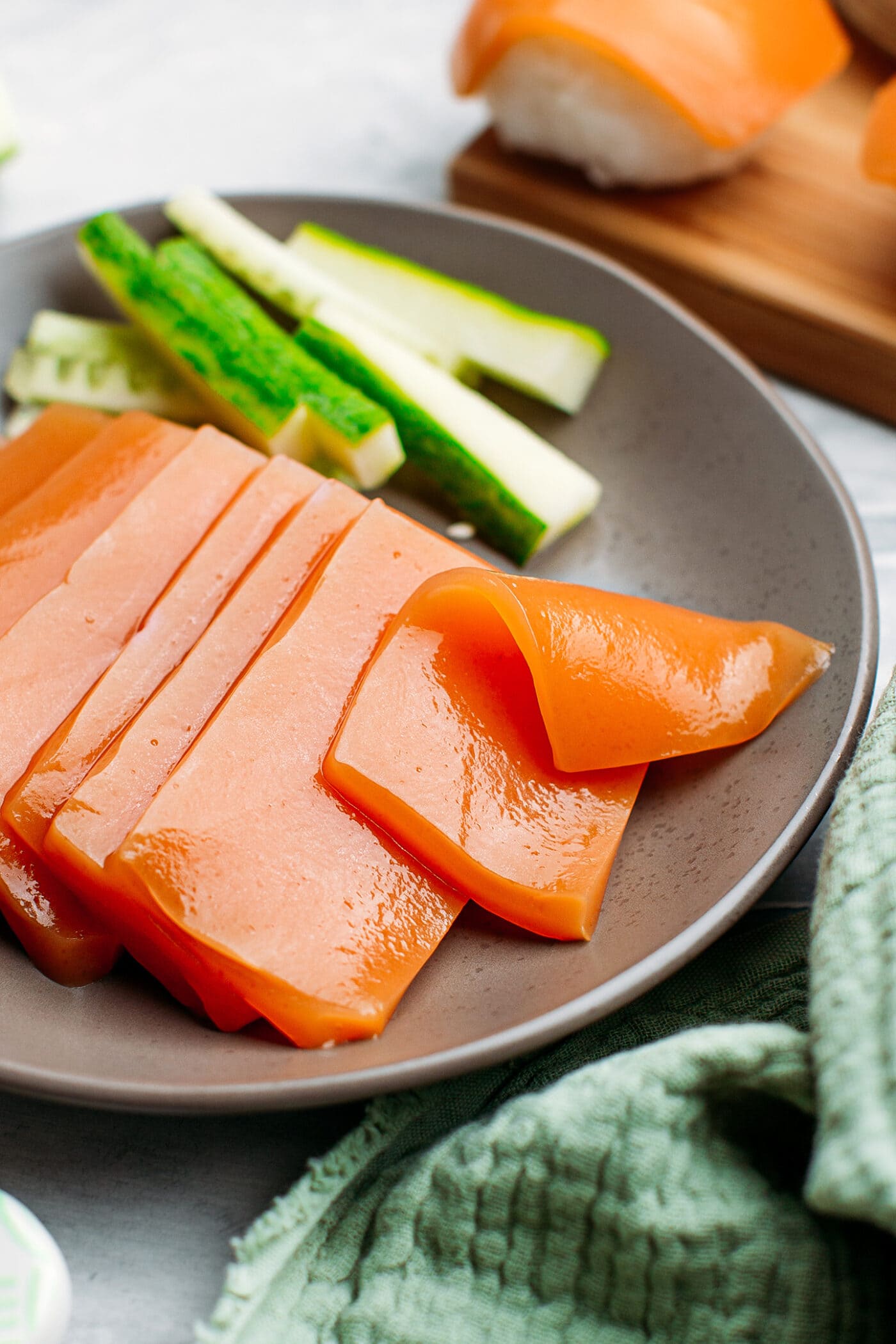
📔 Tips
- Do not use soy milk. Soy milk tends to create foam very easily while whisking it, creating a lot of bubbles in the final texture. To prevent that, use almond or oat milk instead.
- Do not omit or substitute ingredients. This recipe is not really customizable, so any change in the ingredients will affect the final texture and flavor. Ingredients are also given in grams for a more accurate result, so I highly recommend using a kitchen scale.
- Remove the salmon loaf from the pan as soon as it has firmed up. Especially if using a metal mold. There seems to be a reaction between the metal and the seaweed that creates a weird taste if you leave the salmon in a metal pan overnight. I recommend using a plastic or glass pan or removing the salmon from the pan no longer than 2 hours after making it if using a metal one.
- Make thin slices. The best way to enjoy this vegan salmon is when it’s sliced thinly.
- Lightly season sushi rice. If using this salmon to make sushi or nigiri, do not season your sushi rice too much otherwise, it will overpower the flavor of the salmon.
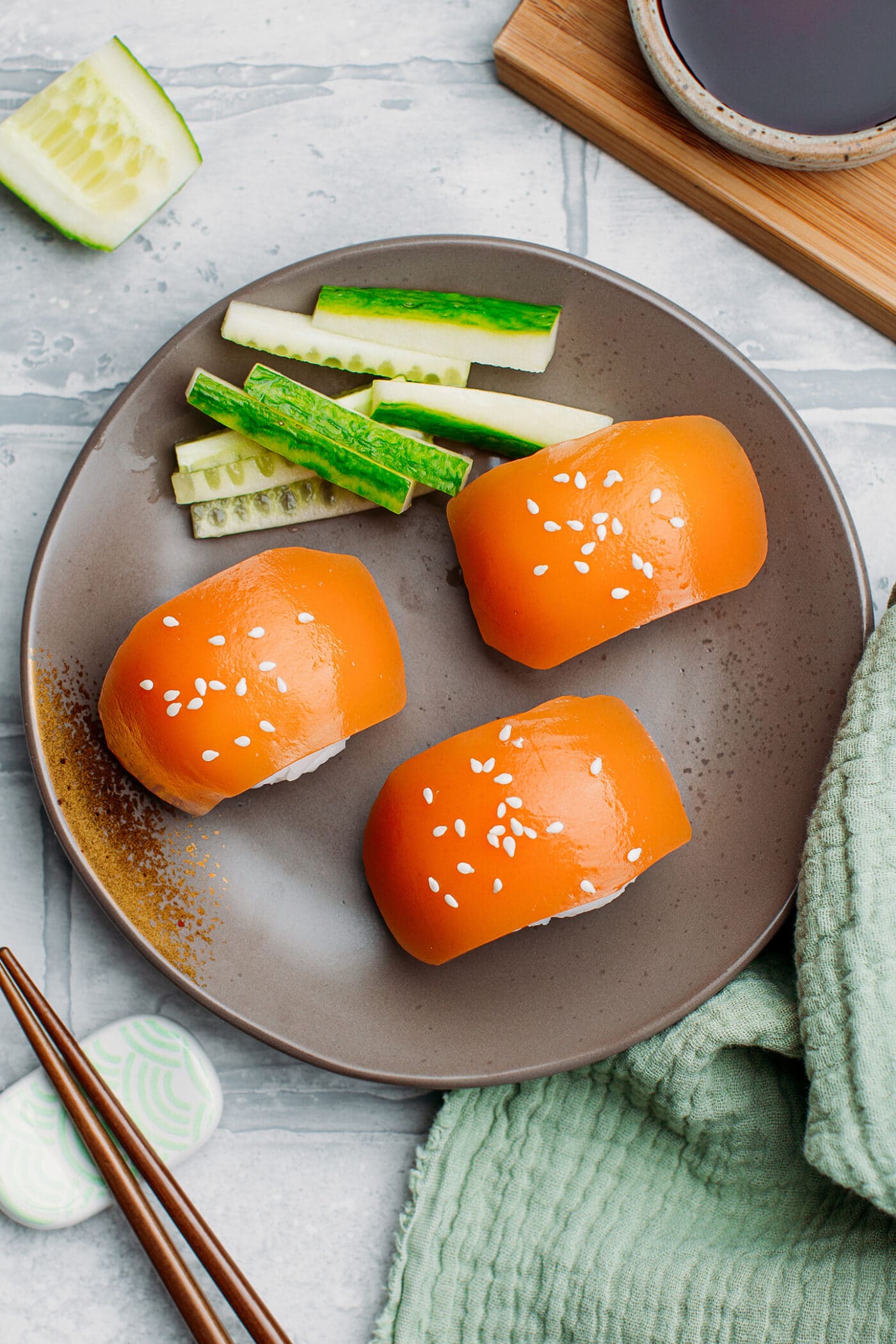
A More Realistic Salmon
Is it possible to make those fat lines that make salmon sashimi so special?
The short answer is yes. It is possible but quite tricky. After tens of trials, I finally succeeded in making layers of white fat. The secret lies in pouring a thin layer of white jelly while the surface of the orange layer is just set but still sticky.
To do that, you need to create a second batter using only almond milk (no orange coloring) and keep both over low heat to prevent them from firming up. Pour a thin layer of the white batter over the orange layer once it has formed a thin skin on top. Once the white layer has also formed a thin skin, pour another layer of orange. Repeat until all of the batters have been used.
If you want to give it a try, feel free to do so. However, I don’t think it’s worth the hassle. The first reason is that it adds nothing to the taste or texture. The second reason is that it’s quite tricky, and if you pour each layer a bit too late, you will end up with them separating once set. You can see below how this version looks.
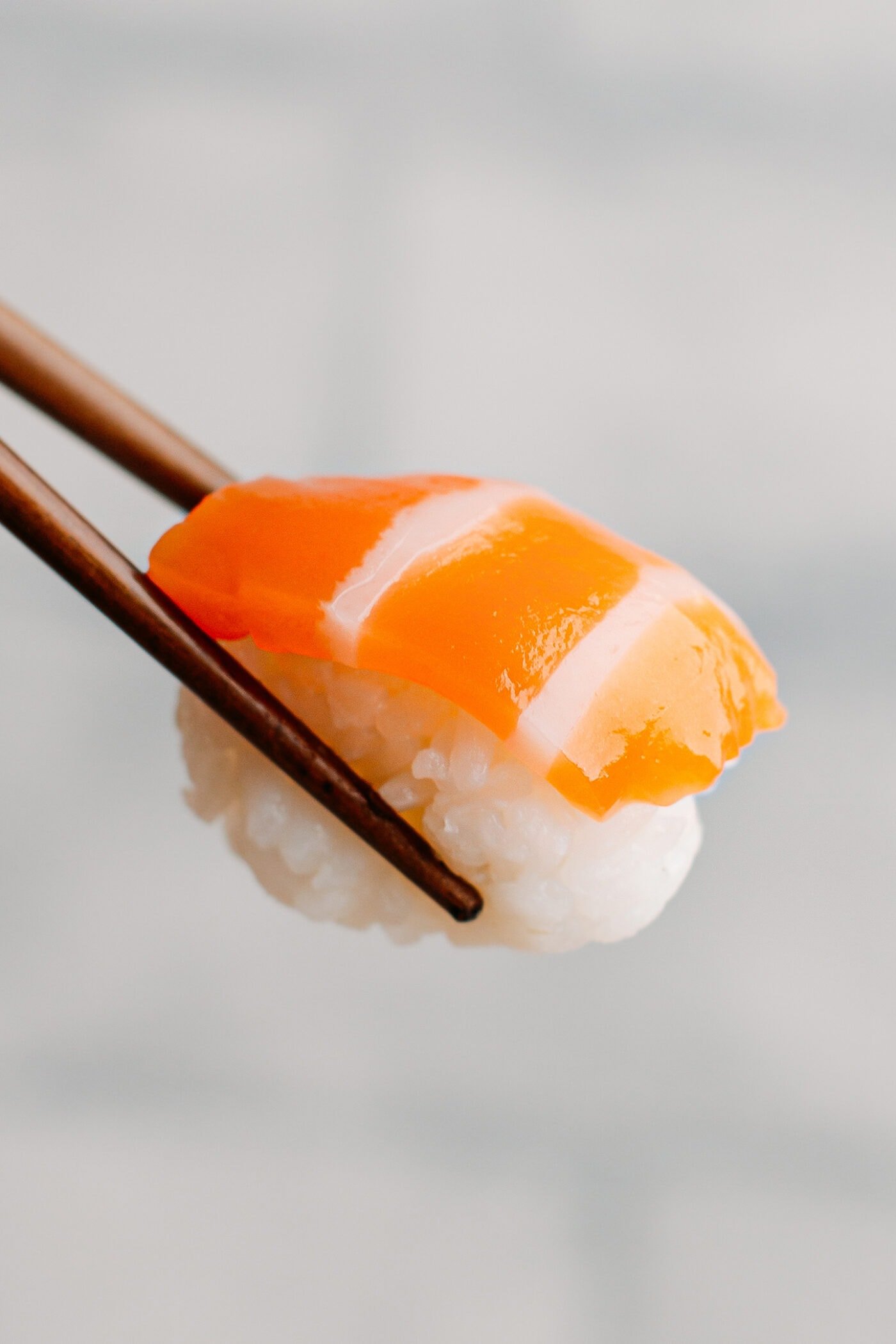
💬 FAQ
Obviously, it doesn’t have the exact same texture, but it’s pretty close! It’s genuinely a fantastic alternative. I asked non-vegans to test it, and while they agreed it was quite different from real sashimi, they really liked it!
Unfortunately no. You must rely on food coloring if you want a vibrant orange color like in the photos. I tried using annatto oil, carrot juice, and carrot powder, but none yielded satisfying results. You can, however, use powdered food coloring. It will give you the same results as liquid coloring.
No, agar will not give you the same texture. The konjac-based jelly powder is essential and cannot be substituted in this recipe.
You should use Konnyaku jelly powder that contains carrageenan, Konnyaku powder, and optionally vegetable gum. Be careful not to buy the sweetened Konnyaku. It should not contain any sugar. I highly recommend using the Jim Willie Konnyaku brand. It’s the one I used.
This vegan salmon is supposed to be enjoyed “raw” as salmon sashimi, so it cannot be baked or cooked.
You can keep it for up to 4 days in the refrigerator.
Note: This recipe took me a lot of trial and error, so please don’t republish under your name, and give credit when using it.
I hope you are going to love this vegan “salmon” sashimi! It’s fatty, fishy, and melts in your mouth! Even non-vegans will be impressed!
🍗 More Vegan Meat Alternatives
Let me know in the comments if you try this recipe!
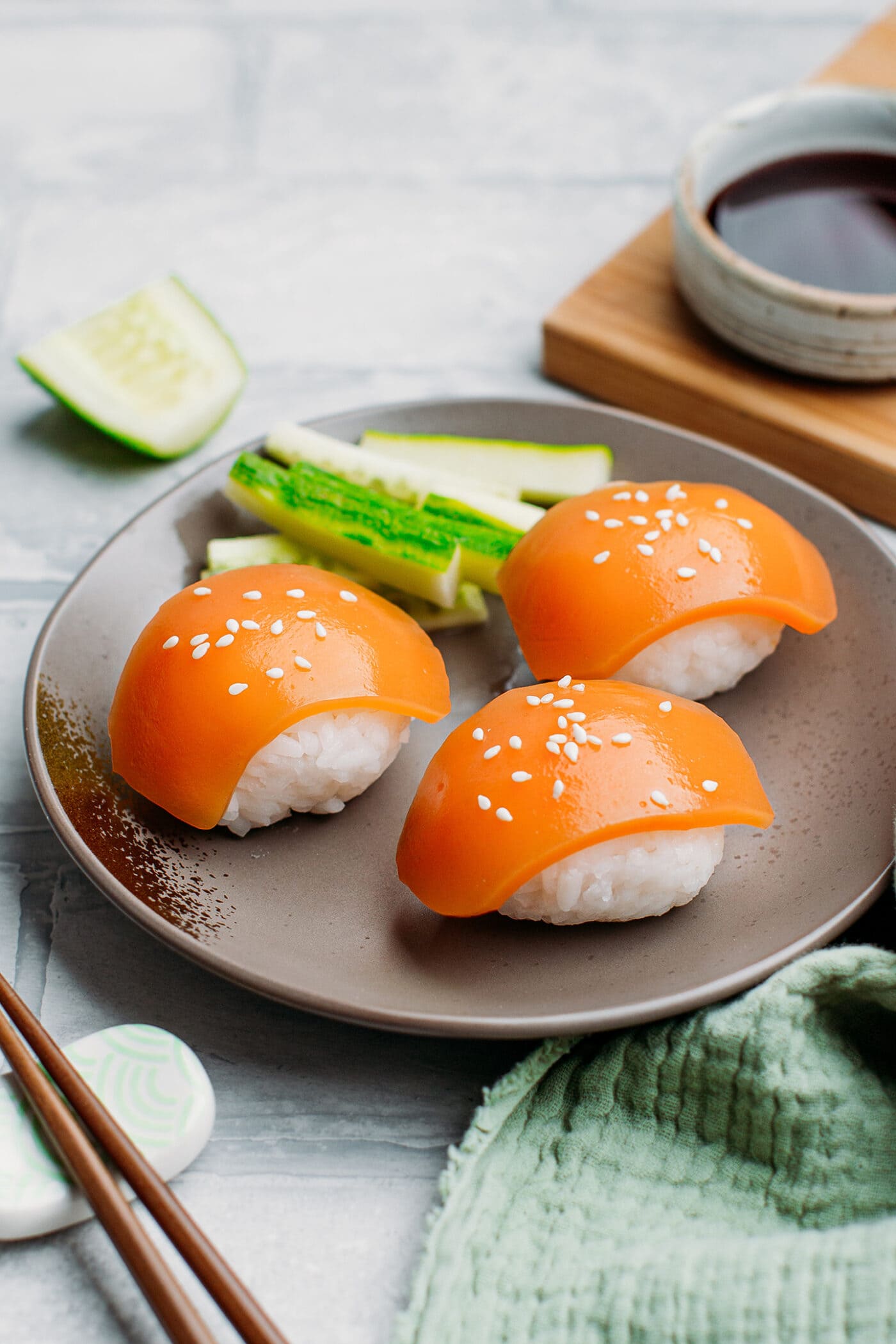
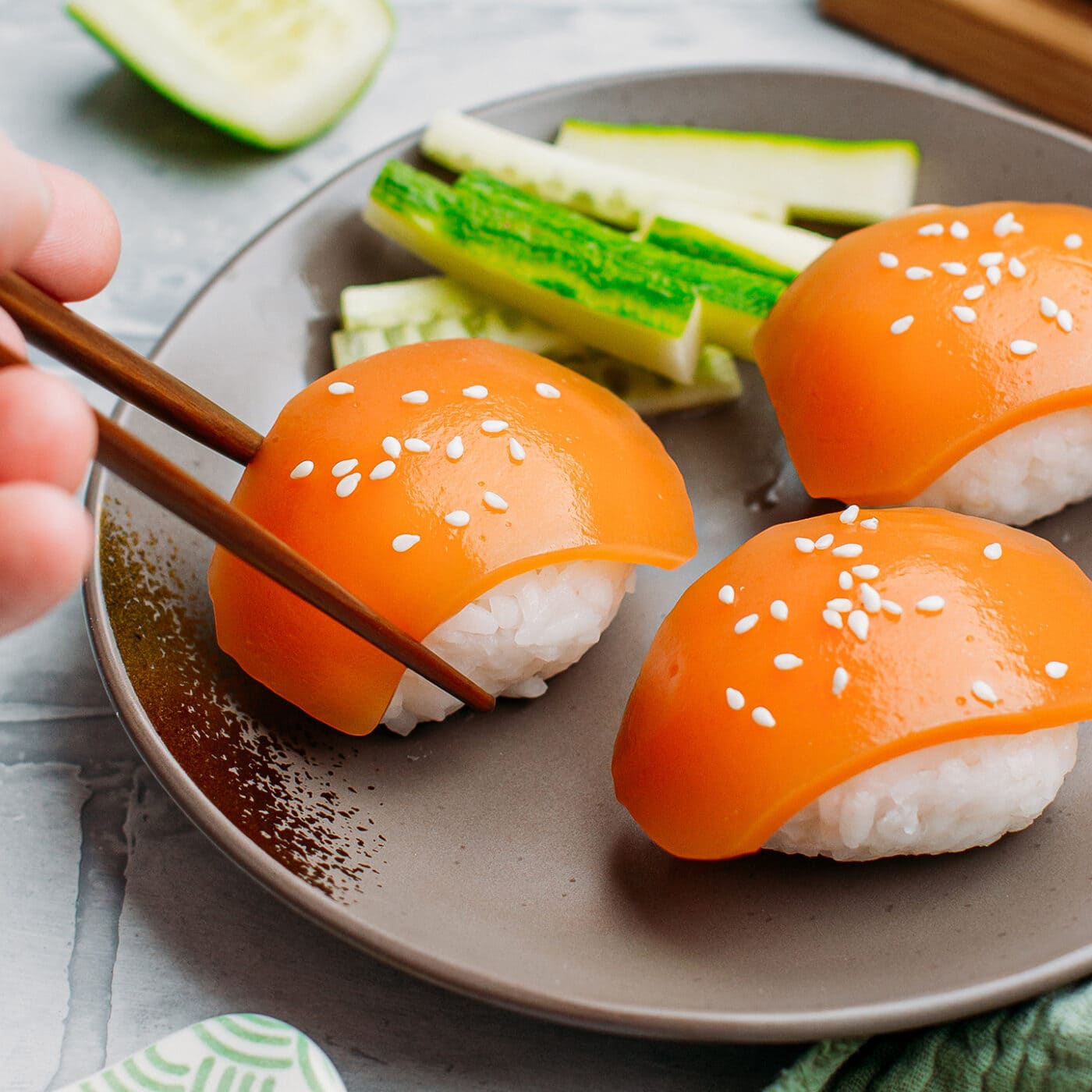
Vegan Salmon Sashimi
Equipment
Ingredients
- 320 ml water
- 1/2 sheet nori seaweed
- 60 ml unsweetened almond milk
- 5 g sugar
- 3 g salt
- 12 g tapioca starch
- 5 g konnyaku jelly powder
- 1 ml orange food coloring about 1/4 tsp
- 10 ml oil
Instructions
- Line a 5×2-inch pan with parchment paper. You can use what you have on hand, any pan or container works.
- Heat half of the water (160ml) over medium heat until just warm. Transfer to a bowl. Add the nori seaweed and let it sit for 10-15 minutes. Strain the seaweed and discard it to keep only the seaweed-infused water.
- Add the seaweed water and the remaining water to a saucepan (the total should be 300ml. If not, add more water).
- Next, add the almond milk, sugar, salt, tapioca starch, and Konnyaku powder. Whisk until the tapioca and Konnyaku are dissolved. Add the orange food coloring and the oil and whisk again.
- Heat over medium heat, constantly whisking until it comes to a boil and thickens. This step will take 3-6 minutes.
- Transfer to the prepared pan and let it cool at room temperature for at least 1 hour before transferring it o the refrigerator. Refrigerate for another 1 hour before removing from the pan.
- Using a very sharp knife, slice the vegan salmon into 1/4-inch thick slices. Use it to make nigiri, sushi, or in sandwiches, toasts, and more!
- This vegan salmon sashimi will keep for up to 4 days in the refrigerator.
Notes
- Do not use soy milk. Soy milk tends to create foam very easily while whisking it, creating a lot of bubbles in the final texture. To prevent that, use almond or oat milk instead.
- Do not omit or substitute ingredients. This recipe is not really customizable, so any change in the ingredients will affect the final texture and flavor.
- Remove the salmon loaf from the pan as soon as it has firmed up. Especially if using a metal mold. There seems to be a reaction between the metal and the seaweed that creates a weird taste if you leave the salmon in a metal pan overnight. I recommend using a plastic or glass pan or removing the salmon from the pan no longer than 2 hours after making it if using a metal one.
- Make thin slices. The best way to enjoy this vegan salmon is when it’s sliced thinly.
- Lightly season sushi rice. If using this salmon to make sushi or nigiri, do not season your sushi rice too much otherwise, it will overpower the flavor of the salmon.
Nutrition

About the Author
Thomas Pagot is the founder, photographer, and recipe developer behind Full of Plants. He created the blog in 2016 as a personal cookbook for vegan recipes. Through years of recipe development, Thomas has successfully grown Full of Plants into a trusted resource for plant-based recipes.
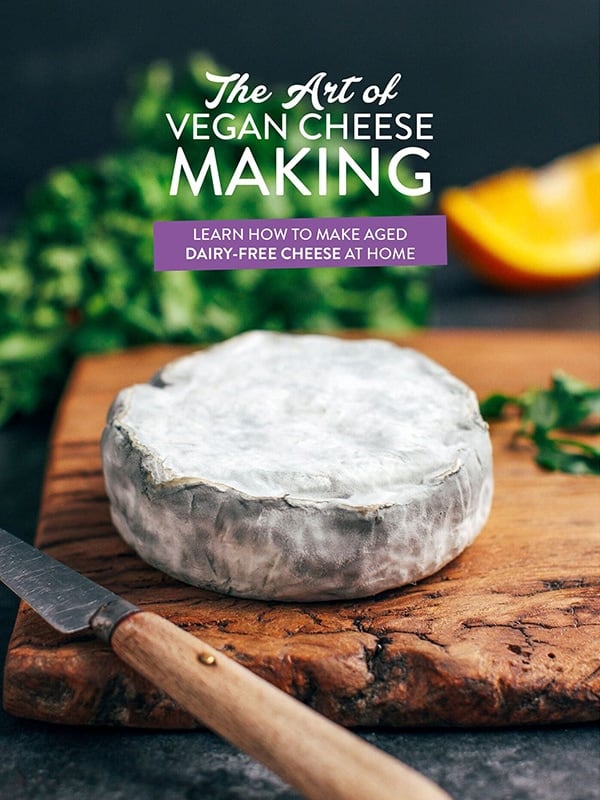
🧀 25 Mind-Blowing Vegan Cheese Recipes!
Sign up for the Full of Plants newsletter and you’ll get new recipes delivered by email weekly, PLUS your FREE 100-page printable eBook!

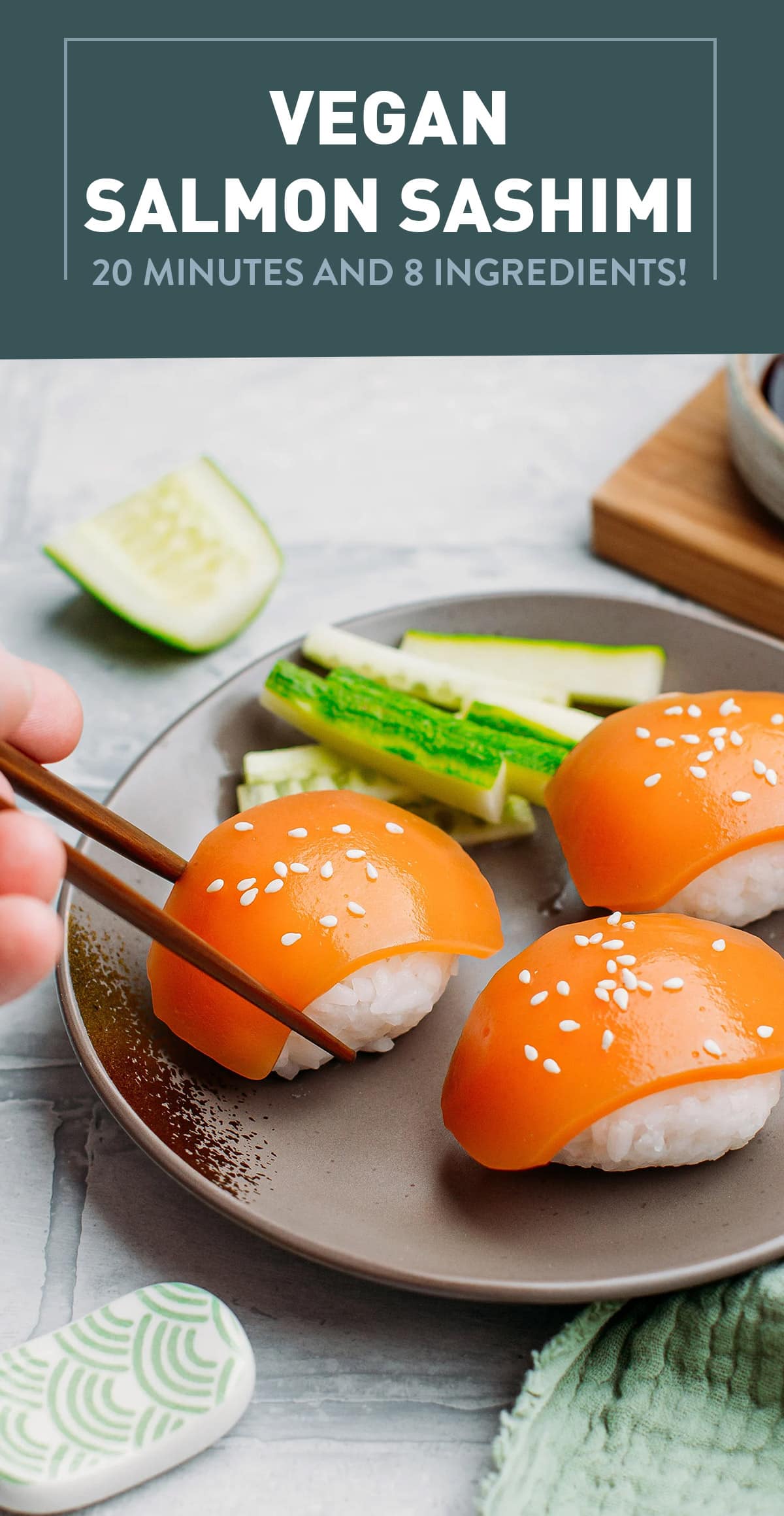
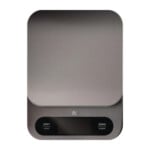
Is konnyaku jelly powder the same as Pure Konjac Gum [Glucomannan Powder] ?
It’s not exactly the same, and it depends on the brand. The one I use contains carrageenan, Konnyaku jelly powder, and vegetable gum (those ingredients help emulsify everything).
I tried this recipe using 100% konjac powder, but the texture was much softer and didn’t have the same “meatiness”. I’ll try again in the future using pure konjac powder and increase the amount to see how it turns out.
Tom, please try it with konjac gum 🙃🙈 I want to try your recipe, but I can’t find konnyaku powder in my country. Bad…
Where are you from? If you have an Asian grocery store nearby, you should be able to find it.
I’m from Russia. All I could find was a ready-made konnyaku jelly with different fruit flavors. Let’s see, maybe in the future pure powder will be supplied to the Russia. Here, in this country, vegans have quite limited opportunities.
Anyway, Tom, thank you very much for your work and experiments! 😊🤝🏻
I would be so happy if you did that! Should I try to add carrageenan maybe?
Cant find konjac jelly anywhere, only pure 100% supplement
This looks amazing. I really love that it is gluten free and I can try it.
Thanks Catherine! 🙂
bonjour ! merci pour cette recette, elle à l’air incroyable !! ❤️
une petite question, ou peut on acheter le jelly powder en france, il peux être remplacer par quelque chose de plus “commun” ?
Bonjour,
Merci ! Oui, le jelly powder est disponible dans presque toutes les épiceries asiatiques ou en ligne.
WOW! I CANNOT wait to get these ingredients. You are a genius! Wonder if you can copyright your recipes?
Thanks Deb 🙂 Hope you will like this vegan “salmon”!
Ah ha! This is the recipe I has been looking for the whole time. I can’t enjoy salmon sashimi using carrots. That doesn’t have the texture of the real salmon at all.
Thanks for sharing. I can’t wait to try it. And I’ll come back to rate later. Wish me luck!😉
Well, this one has a texture closer to the real thing. I hope you will like it!
Hey, it’s me, Jodie. I said I would come back to rate after trying the recipe, but I was so swamped that I couldn’t have time to do it. Now here I am, again. I tried your recipe not just once but many times. I even tried to do it with the white layers to see if it worked.
And you know what, it was fantastic!!!!! My parents and friends found it amazing too. They even asked for the recipe. Lol. I love cooking. And it was fun to make something interesting like this sometimes because it really helped me get rid of the stress I got from work. Thank you so much for the recipe, and I wish you all the best!!!
Jodie
That’s awesome! 🙂 I’m really happy to hear you and your parents liked this vegan salmon!
Wishing you all the best as well!
Hi! I only have Dulse on hand from the seaweedman in maine, would that work for the seaweed? I love the taste of it!
I’m constantly amazed at how you lead us to so many new flavors and foods. Thank you for all of your efforts. It’s not lost on us.
Hi Annie,
Yes, dulse will definitely work! If it’s in flakes, I would probably use about 2 tbsp.
I hope you will like this vegan “salmon”! 😉
Finally a recipe that doesn’t make use of carrots! Excellent work, will try it very soon.
Hope you will enjoy it Tommy!
I think this is trying to be something it can not be just for the sake of it. It has no nutritional value and looks like a oiece of chewing gum sat on a rice ball.
Then this recipe is not for you. Rating it 1 star without even trying it is not cool. Hence I removed your rating.